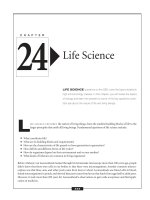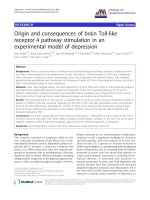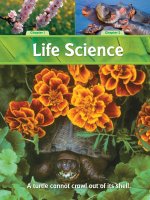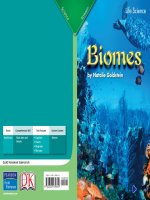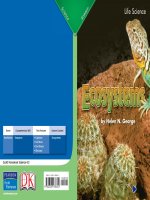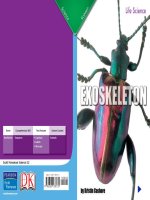4 3 life in an ecosystem (life science)
Bạn đang xem bản rút gọn của tài liệu. Xem và tải ngay bản đầy đủ của tài liệu tại đây (4.56 MB, 14 trang )
Genre
Nonfiction
Comprehension Skill
Sequence
Text Features
•
•
•
•
Labels
Captions
Diagrams
Glossary
Science Content
Ecosystems
Scott Foresman Science 4.3
ISBN 0-328-13866-5
ì<(sk$m)=bdig b< +^-Ä-U-Ä-U
Vocabulary
carnivores
community
decomposers
ecosystem
herbivores
niche
omnivores
population
What did you learn?
1. How are plants important to most
food chains?
2. What are some examples of nonliving
things in an ecosystem?
3. How does the shallow ocean ecosystem
differ from the deep ocean ecosystem?
4.
There are many kinds
by Donna
Latham
of ecosystems. Write to explain how they
differ from each other. Include details
from the book to support your answer.
5.
Picture Credits
Every effort has been made to secure permission and provide appropriate credit for photographic material.
The publisher deeply regrets any omission and pledges to correct errors called to its attention in subsequent editions.
Photo locators denoted as follows: Top (T), Center (C), Bottom (B), Left (L), Right (R), Background (Bkgd).
1 © Kim Taylor/DK Images; 6 (TR) ©Jerry Young/DK Images; 8 Bryan & Cherry Alexander/Photo Researchers, Inc.;
10 (BR) ©Darren Bennett/Animals Animals/Earth Scenes; 11 (BR) Tim Fitzharris/Minden Pictures;
15 (BR) ©Jerry Young/DK Images; 16 (BL) ©Jerry Young/DK Images; 17 (CL) David Wrobel/Visuals Unlimited;
19 (C) Roland Birke/Phototake, (CR) Jeff Rotman/Nature Picture Library; 21 (R) Omni Photo Communications Inc./
Index Stock Imagery; 22 (TL) © Kim Taylor/DK Images, (R) Jim Zipp/Photo Researchers, Inc.
Scott Foresman/Dorling Kindersley would also like to thank: 7 (TL) Stephen Oliver/DK Images;
13 (TR) Philip Dowell/DK Images; 17 (BL) Natural History Museum, London/DK Images; 19 (CR) Jerry Young/DK Images.
Unless otherwise acknowledged, all photographs are the copyright © of Dorling Kindersley, a division of Pearson.
ISBN: 0-328-13866-5
Copyright © Pearson Education, Inc. All Rights Reserved. Printed in the United States of America.
This publication is protected by Copyright, and permission should be obtained from the publisher prior to any
prohibited reproduction, storage in a retrieval system, or transmission in any form by any means, electronic,
mechanical, photocopying, recording, or likewise. For information regarding permission(s), write to
Permissions Department, Scott Foresman, 1900 East Lake Avenue, Glenview, Illinois 60025.
3 4 5 6 7 8 9 10 V010 13 12 11 10 09 08 07 06 05
Sequence Use sequence words such
as first, next, and last to explain the
food chain.
The Ecosystem
and Its Parts
What a view! You are in the forest.
From your perch on the hill, you can
easily see a pond below you and the
Sun shining above you. A frog croaks
noisily. You focus your binoculars on
the cattails that rustle in the breeze.
You close in on the dragonflies resting on them.
You zoom in on a family of ducks paddling along
noisily. The ducklings at the end of the line hurry to
keep up. At the edge of the pond, a great blue heron
waits patiently in the reeds. You watch quietly as
the heron drops its head down into the water.
When it jerks back up, you see the wriggling
fish in its bill. You may not realize it, but you
are watching an amazing system in action.
2
What is a system?
A system consists of many parts working together
for a purpose. In a system, there are both living and
nonliving parts. Every part of a system is important.
If any part of a system is lost or damaged, the whole
system is affected. It does not work as well.
Take another look through your binoculars at the
pond in the forest. What living things do you see? The
ducks and the heron are birds. The frog is an amphibian.
The dragonflies are insects, and the cattails are plants.
They are all alive. What nonliving parts can you think
of? Air, water, soil, sunlight, climate, and landforms are
all nonliving parts. All of these parts of the system are
working together. Let’s find out how!
3
Many Ecosystems
One important kind of system
is an ecosystem. An ecosystem is
made of living and nonliving things
interacting and working together.
They have the same environment,
or place, in nature. They interact
with each other, and they affect what
happens to one another. The ways
they interact keep the ecosystem alive.
Ecosystems may be large or small.
One large ecosystem is the forest you
just visited. The pond is a smaller
ecosystem within the forest. A fallen
tree is an even smaller one. All these
ecosystems are homes to living and
nonliving things that work together.
This fallen tree is a small
ecosystem. What living things
are interacting with it?
4
Organisms are only able to live in environments
that give them what they need to survive. In any
environment, some animals and plants can survive.
Others cannot survive. Plants and animals adapt
in order to stay alive. This means that the way
they look and act helps meet their needs in their
surroundings.
Ecosystems vary depending on the climate. The
world is made of many different climates, so there
are many ecosystems. Different plants and animals
make their homes in different kinds of ecosystems.
Let’s learn about each type.
5
Arctic Tundra
Forest
The ground is frozen under the
surface in an Arctic tundra.
No trees can grow there.
Arctic foxes, polar bears, and
wolves have adapted to
live in the cold weather
of the Arctic tundra.
Rich with trees, wildflowers,
and many animals, forests
usually get more rain than
grasslands. Deer, raccoons,
foxes, and many birds interact
in this ecosystem.
Desert
Grassland
Covered in tall grasses, grasslands have a moderate
amount of rain. Pronghorn sheep, bison, and coyotes
are found in the grasslands of the United States.
Very dry and often hot, deserts see
almost no rain. Some plants, including
cacti and some grasses, are adapted for
life with nearly no water.
So are some animals,
including lizards, snakes,
and kangaroo rats.
Rain Forest
There is rain all year in a
tropical rain forest. Palms,
ferns, and vines can grow
there. Colorful birds, bats,
monkeys, and snakes are some
of the animals that live there.
6
7
Organisms in Their Ecosystem
Finding a Niche
There are many different species that live in
ecosystems. A population is all the members of one
species living in a part of an ecosystem. In the pond,
you saw two different bird populations. In a desert,
you might see a population of prairie dogs. Different
populations in an ecosystem interact with one another
and form a community. All the organisms that live in
the forest ecosystem are a community.
The job an organism does is its niche. A niche is the
role an organism has in its habitat. A niche is also the
food an organism eats and how it gets that food. It even
includes the species that will use that organism for food.
The cape ground squirrel, the scorpion, and the
tortoise share a desert habitat but have different niches.
The cape ground squirrel uses its bushy tail to shade
itself from the Sun. It eats grasses, seeds, and nuts. The
scorpion hides from the day’s heat by burrowing. It eats
insects, lizards, and small animals. The tortoise finds
shade during the hottest part of the day. It eats plants.
Habitats
A habitat is the place where an organism lives
within an ecosystem. The tundra is an ecosystem.
During the winter months, a polar bear in the
tundra digs a den into the side of a hill. The den
is its winter habitat.
8
9
Energy in Ecosystems
Sunlight is the main source of energy for all life
on Earth. Plants change sunlight energy into chemical
energy through a process called photosynthesis. Since
plants make their own food, they are called producers.
Many organisms cannot make their own food.
Organisms that eat other living things to get energy
are called consumers. Herbivores are consumers that
get energy from eating plants. Deer, zebras, and moose
are herbivores. Carnivores get energy from eating
animals. Predators such as sharks, lions, and coyotes
are carnivores. Omnivores, such as bears and raccoons,
eat both plants and animals. Some consumers, such as
vultures, are known as scavengers. Scavengers feed on
the bodies of dead plants and animals.
10
The Food Chain
All living things must have food to
stay alive. Energy moves from one living
thing to another through a food chain.
Energy transfers through the food chain
when organisms eat and are eaten.
Food chains begin with energy from the
Sun. This energy goes to producers, and
from there it is passed to consumers.
In the food chain you see here, the
arrows show how the energy is transferred
from the “eaten” to the “eater.” The Sun
gives energy to the grass. The jackrabbit
receives this energy when it eats the grass.
The energy flows to the coyote when it
eats the jackrabbit. The mountain lion
eats the coyote and gets energy.
11
Why is the food
chain important?
Imagine an ecosystem
that had only producers
and consumers. What
would happen? In time, plants would take all
the minerals from the soil. With no minerals
left, these plants would die. With no plants to
eat, herbivores would starve. Omnivores and
carnivores would then have no food and
would also starve.
You can see how one missing piece in the
chain affects all the others. When minerals are
not replaced, new organisms cannot grow.
This is why decomposers are important
in the food chain.
Decomposers eat the wastes and
remains of dead plants and animals.
Those remains still have food energy
stored inside them.
12
Decomposers
improve the soil in
an ecosystem.
Some bacteria, insects, and fungi
are decomposers. They break down dead
plant and animal tissues into minerals and
nutrients. The minerals and nutrients are
put back into the air, water, and soil of the
ecosystem. Plants take these nutrients from
the soil, and the chain keeps going! Energy
released by decomposers transfers all the
way through a food chain.
Fungi break down dead plants
and animals. They put nutrients
back into the soil.
13
Food Webs
You have seen how a food chain operates. One
form of life eats another, which eats another, and
so on. An ecosystem can have many food chains.
The same source of food can be part of more than
one chain. These chains overlap and form
a food web. A food web shows how
many food chains interact.
A food web is more complex
than a food chain. It lets you see how
different food chains in an ecosystem
are related.
Let’s go back to the pond you visited earlier.
This food web shows you how the food chains in
the pond overlap. Start with the marsh grass. Both
rabbits and grasshoppers eat this food source.
Which consumers eat grasshoppers? Which
consumers eat rabbits? By looking at the web, you
can see that bullfrogs eat grasshoppers. And both
hawks and foxes eat rabbits. This means that hawks
and foxes compete for rabbits. Can you see how
food energy flows in many directions?
grasshopper
bullfrog
hawk
fox
marsh grass
rabbit
14
15
Matter in Ecosystems
You know that all organisms need energy to survive.
They also need matter. Matter includes minerals,
oxygen, and carbon dioxide. When organisms die and
decay, this matter goes back to the ecosystem.
Water Ecosystems
Nearly three-fourths of Earth’s surface is
covered with water. This means many organisms
live in water ecosystems. Let’s find out what
those ecosystems are like!
Brackish Wetlands
Brackish water is a mix of fresh and salt water.
Saltwater swamps support a lot of plant and animal
life. Carnivores, such as alligators and crocodiles, hunt
on land and in the water. Turtles eat both plants and
animals, while waterfowl eat only plants.
Shallow Ocean
All ocean water is salty. Coral reefs are found in
shallow ocean areas. Coral reefs are made of coral
skeletons. Lots of sunlight reaches this ecosystem, so
many plants and animals make their homes here.
Deep Ocean
Freshwater Wetlands
The shores of freshwater ecosystems, such as
ponds, can have many habitats. Many other habitats
are below the surface of the water. Water plants live
in the water. Fish, which live underwater, eat the
water plants. Egrets and cranes can
go fishing from the shore!
16
The organisms that can survive
in the dark, deep ocean have
adapted to do so. Many, such as this
viperfish, have large eyes. They take
in what little light there is. They
have a big jaw and long teeth. This is so they can open
their mouths wide and hold on tightly to their prey.
17
A Coral Reef Food Web
You know that a food web shows the
connection of several food chains. In a coral reef,
a food web might look like this.
The coral reef food web begins with producers,
such as blue-green algae. They use nutrients in the
water and sunlight to carry out photosynthesis.
Then two consumers eat the algae. The first
consumer, the sea urchin, has a soft body.
A spiny shell protects it. The second consumer
is the parrotfish. It uses its strong beak to tear
algae off coral.
Despite their spiky armor, sea urchins do
get eaten on the reefs! Parrotfish do too.
Which consumers eat sea urchins and
parrotfish? By looking at the web, you
can see that sea stars eat sea urchins.
The moray eel, with its very sharp
teeth, eats parrotfish. The shark, a
fierce predator on the reef, also eats
parrotfish. Can you see how the
flow of food energy branches out?
It goes in many directions.
18
In this web, the algae use sunlight and matter to
grow. Their environment gives them what they need to
live. The sea urchin and the parrotfish eat algae to grow.
Carnivores, in turn, eat them. This is how the energy
flows through the food web.
moray eel
shark
blue-green algae
parrotfish
sea star
sea urchin
19
Decay
Every living thing dies. It then rots, or
decays. Decay is a very important process in
an ecosystem. Without decay, there would
be too many dead organisms, and wastes
would pile up. The habitats of living things
would suffer.
How does decay happen? A scavenger,
such as a vulture, may feed on the remains
of a dead animal. Then decomposers, such
as fungi and bacteria, break down what is
left. They put minerals and nutrients back
into the ecosystem.
Did you know that dead organisms decay
in different ways? In heat, decay is quick.
In colder temperatures, decay slows down.
Think of an apple. Would it rot faster in the
refrigerator or outside in the sunlight?
Oxygen and moisture also affect decay.
Decomposers need these things to live and
grow. So the presence of oxygen and
moisture speeds decay.
20
The Process of Decay
Scavengers feed
on the remains of
a dead animal.
Decomposers
further break
down the dead
animal into
minerals and
nutrients.
These minerals
and nutrients
return to the soil,
allowing new
plants to grow.
21
Seeing the Pond
with New Eyes
You’re back! Once again,
you have settled in on the hill
to watch the action in the
pond below.
Now you realize you are
watching an ecosystem. As you
look up at the Sun, you know
that it is the energy source in
the forest. All around you, the
food chain is under way.
You wonder which
consumers might be eating the
cattails swaying in the breeze.
You search for grasshoppers
that are eating grass. Now a
frog snatches a fly from the air.
You are relieved when the frog
hops away before the hawk in
the tree above you spots it.
22
As you look at the fallen
tree near the pond, you know
that it could be an ecosystem
too. The organisms living in it
could be interacting in a food
chain. They could be in the
process of decay.
You have learned that an
ecosystem is made of living
and nonliving things that work
together. They fit together like
parts of a puzzle. Each part
of the puzzle helps keep the
ecosystem alive.
23
What did you learn?
Vocabulary
carnivores
community
decomposers
ecosystem consumers that get energy from
carnivores
herbivores eating animals
niche
omnivores different populations that interact
community
population with each other in an ecosystem
Glossary
decomposers organisms that break down
dead organisms
ecosystem
an environment in which living and
nonliving things interact
herbivores
consumers that get energy from
eating plants
Picture Credits
Every effort has been made to secure permission and provide appropriate credit for photographic material.
The publisher deeply regrets any omission and pledges to correct errors called to its attention in subsequent editions.
Photo locators denoted as follows: Top (T), Center (C), Bottom (B), Left (L), Right (R), Background (Bkgd).
niche
the special role or job of an organism
in its habitat
1 © Kim Taylor/DK Images; 6 (TR) ©Jerry Young/DK Images; 8 Bryan & Cherry Alexander/Photo Researchers, Inc.;
10 (BR) ©Darren Bennett/Animals Animals/Earth Scenes; 11 (BR) Tim Fitzharris/Minden Pictures;
15 (BR) ©Jerry Young/DK Images; 16 (BL) ©Jerry Young/DK Images; 17 (CL) David Wrobel/Visuals Unlimited;
19 (C) Roland Birke/Phototake, (CR) Jeff Rotman/Nature Picture Library; 21 (R) Omni Photo Communications Inc./
Index Stock Imagery; 22 (TL) © Kim Taylor/DK Images, (R) Jim Zipp/Photo Researchers, Inc.
omnivores
consumers that get energy from
both
and Kindersley,
plantsa division of Pearson.
Unless otherwise acknowledged, eating
all photographs
are theanimals
copyright © of Dorling
Scott Foresman/Dorling Kindersley would also like to thank: 7 (TL) Stephen Oliver/DK Images;
13 (TR) Philip Dowell/DK Images; 17 (BL) Natural History Museum, London/DK Images; 19 (CR) Jerry Young/DK Images.
population
ISBN: 0-328-13866-5
all the members of one species in
an ecosystem
Copyright © Pearson Education, Inc. All Rights Reserved. Printed in the United States of America.
This publication is protected by Copyright, and permission should be obtained from the publisher prior to any
prohibited reproduction, storage in a retrieval system, or transmission in any form by any means, electronic,
mechanical, photocopying, recording, or likewise. For information regarding permission(s), write to
Permissions Department, Scott Foresman, 1900 East Lake Avenue, Glenview, Illinois 60025.
3 4 5 6 7 8 9 10 V010 13 12 11 10 09 08 07 06 05
24
1. How are plants important to most
food chains?
2. What are some examples of nonliving
things in an ecosystem?
3. How does the shallow ocean ecosystem
differ from the deep ocean ecosystem?
4.
There are many kinds
of ecosystems. Write to explain how they
differ from each other. Include details
from the book to support your answer.
5.
Sequence Use sequence words such
as first, next, and last to explain the
food chain.
